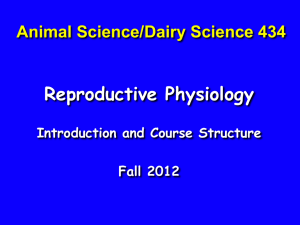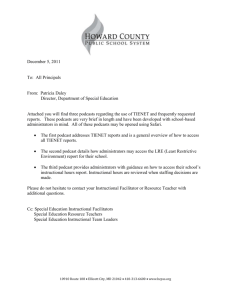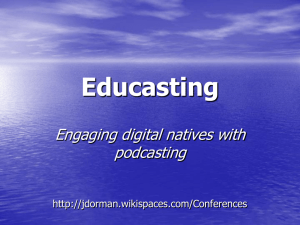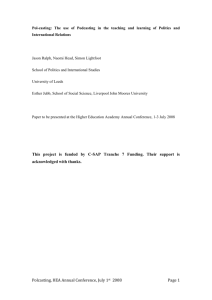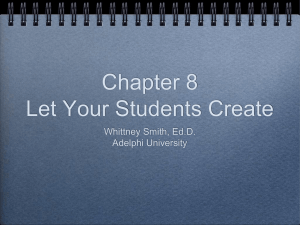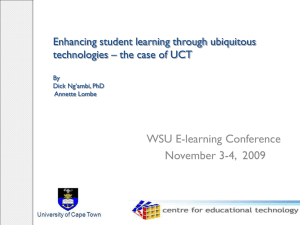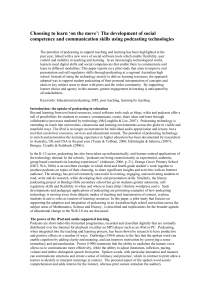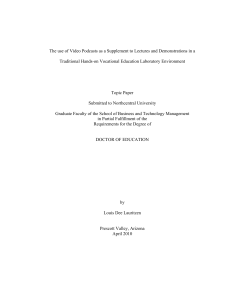File - Tina Bechtel
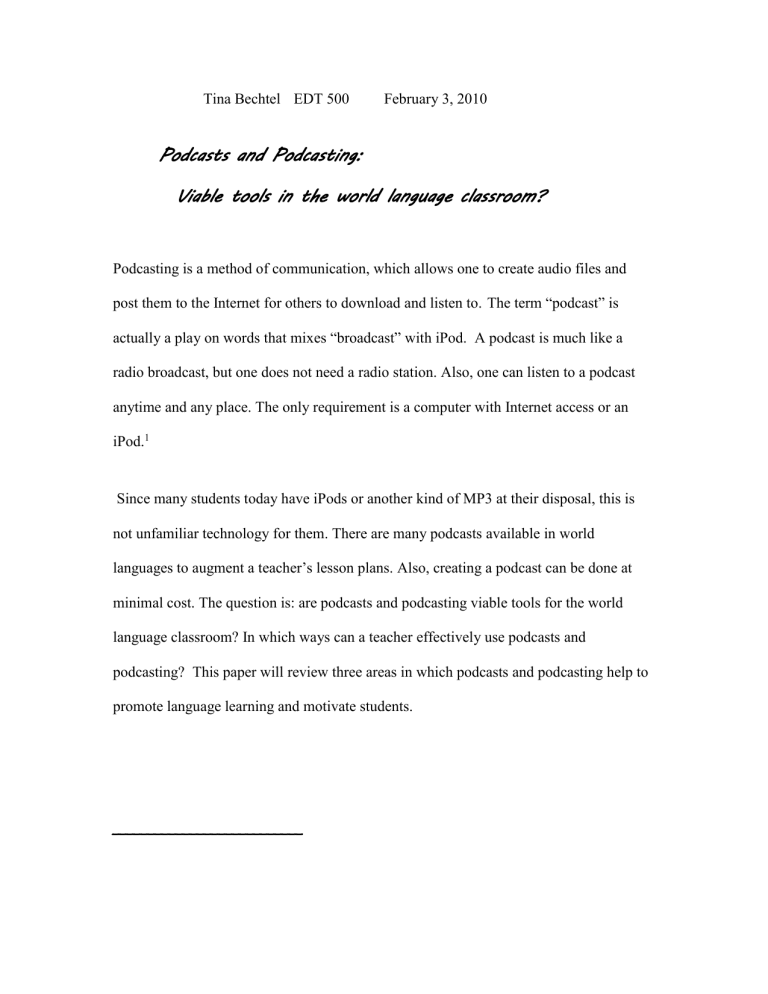
Tina Bechtel EDT 500 February 3, 2010
Podcasts and Podcasting:
Viable tools in the world language classroom?
Podcasting is a method of communication, which allows one to create audio files and post them to the Internet for others to download and listen to.
The term “podcast” is actually a play on words that mixes “broadcast” with iPod. A podcast is much like a radio broadcast, but one does not need a radio station. Also, one can listen to a podcast anytime and any place. The only requirement is a computer with Internet access or an iPod.
1
Since many students today have iPods or another kind of MP3 at their disposal, this is not unfamiliar technology for them. There are many podcasts available in world languages to augment a teacher’s lesson plans. Also, creating a podcast can be done at minimal cost. The question is: are podcasts and podcasting viable tools for the world language classroom? In which ways can a teacher effectively use podcasts and podcasting? This paper will review three areas in which podcasts and podcasting help to promote language learning and motivate students.
___________________________
1
Flippo, Hyde. “Listening to Podcasts in German”. About.com.2010.The New York
Times Company.Retrieved on 1/22/2010 http://german.about.com/od/audiolistening/a/gerpodcast.htm
Podcasts
Podcasts are available in many different languages and can be a great source of authentic input about current news and culture. A good example for younger students is “Die
Sendung mit der Maus”, which brings short cultural and scientific information for children. ( http://www.podcast.de/ ). There are also semi-authentic language podcasts, which are designed especially for language learners. One example of this is SlowGerman
( http://www.slowgerman.com/ ) Students who are very interested can also subscribe to language courses and view these courses while on the go. A good example for this is a free German podcast at http://german-podcast.de/ .
2
Podcasting
Podcasting can be teacher recorded, to distribute lecture material, for example, or student recorded. Student podcasting can empower students by giving them opportunities to create and publish their own work. Teachers can assess oral presentations and other students can give feedback. To create a podcast, one only needs a microphone, sound editing software such as Audactiy (http://audacity.sourceforge.net/), and server space or an account with a free Podcasting service such as Podomatic
( http://www.podomatic.com/director ) 3
__________________________
2
Shelley, Nathan.“Podcasting in the Classroom”.School of the Ephiphay. Archdiocese of
San Francisco.Retrieved on 1/22/2010 http://userwww.sfsu.edu/~nshelley/
3” ”Projects and Ideas- Podcasts”, Langwitches.org.2005-2007.Retrieved on 22/1/2010 http://www.langwitches.org/projects/internet/podcast/index.html
Lara Ducate and Lara Lomcka conducted a study at the University of California to determine whether podcasts created using student scripts actually help improve pronunciation in second language learning. They also wanted to determine whether students’ attitudes changed toward pronunciation.
4 From my own experience, students either do not realize that they are mispronouncing or they are not motivated to pronounce more accurately. Also, in beginning language classes there is little time to spend on improving pronunciation because most of the time is spent on vocabulary building and grammar Thus, these professors hoped that the use of podcasting would be of value in developing correct pronunciation in lower level classes. Their rationale was that
“podcasting may offer a possible option for practicing speaking skills outside of class” and students could “practice pronunciation and… apply their newly practiced pronunciation skills to a more creative, contextualized task.” 5 After making their own recordings, students were required to listen to classmates’ podcasts and then post comments about the content.
4
Ducate,Lara and Lomicka, Lara. “Podcasting: An effective tool for honing language students’ pronunciation?”.Language Learning and Technology.13.2 (2009)
: 66-86
5
(Ducate, Lomicka)
Even though the professors discovered that podcasts were not enough to improve pronunciation over an academic semester, they did feel, however, that podcasting was an additional viable tool in the world language classroom, and perhaps more extensive research was needed to determine long-term benefits.
6
I personally feel that students would have the advantage of becoming aware of their pronunciation and having the podcasts available to an audience would be a great motivation to encourage them to speak more like a native speaker.
Another interesting area where podcasting can be used is podcasting by phone. An intermediate Spanish lecturer Mararita Ribas Groeger, gave her students more opportunity to speak and increase fluency using this method. She used an application called Gabcast ( http://www.gabcast.com/ ) to create recordings. Students could dial a toll free number and record their message. The messages were available for the rest of the class to listen to. She felt that this did, in fact, help with pronunciation and intonation as each student had many more opportunities to speak and be evaluated.
7
__________________________________
6 (Ducate, Lomicka)
7
Cain,James. “Podcasting enables 24/7 Foreign Language Study”.MIT
News.1/3/2007.Massachusetts Institute of Technology. Retrieved on 1/22/2010 http://web.mit.edu/newsoffice/2007/podcasting-fll.html
Usefulness in the Classroom
Whether a teacher decides to use ready-made podcasts or teacher/student recorded podcasting, each of these options meets the following standards for foreign language:
1.
Standard 1.2 Students understand and interpret written and spoken languages on a variety of topics. (Authentic world language podcasts)
2.
Standard 1.3: Students present information, concepts, and ideas to an audience of listeners or readers on a variety of topics. (Student recorded podcasts)
3.
Standard 3. 1 Students reinforce and further their knowledge of other disciplines though the foreign language (both though world language podcasts and recording their own)
4.
Standard 3.2 Students acquire information and recognize the distinctive viewpoints that are only available through the foreign language and its cultures
(world language podcasts)
5.
Standard 5.1 Students use the language both within and beyond the school setting.
(both world language podcasts and student/teacher recorded podcasts)
6.
Standard 5.2 Students show evidence of becoming life-long learners by using the langue for personal enjoyment and enrichment (both world language podcasts and student/teacher recorded podcasts)
8
______________________________________________
8
(Langwitches.org)
It is very clear to me that authentic or semi-authentic podcasts are beneficial for use in the classroom. This is a supplement to the lesson plan, which is not time-consuming or technologically challenging. Podcasting, either recorded by the teacher or by students, is a lot more time-intensive and requires careful planning. However, podcasting is not only beneficial for language practice, it is also a great motivating factor for students.
The additional advantages of using podcasting in the classroom are that students learn the technical skills needed to do this. This is a topic, then, that can be useful outside of the world language classroom. Additionally, through collaboration, students brainstorm, design the themes and content with each other, as well as learn management skills.
Again these skills are all needed in the 21 st
century.
The only drawback to this project-based learning is the time factor. To create a podcast a teacher needs to invest 3 to 4 weeks. This may not always be something that curriculum restraints allow. A teacher must also plan carefully and prepare accurate rubrics to make sure that real learning occurs. In the case of podcasting by phone, this is definitely a great tool for completing oral assessments on a more frequent basis than is possible in a classroom setting. In summary, I personally feel that all aspects of podcasting can be beneficial in the classroom. Currently I use authentic and semi-authentic podcasts, but will definitely plan to implement student- recorded podcasts in the near future.
Cain,James. “Podcasting enables 24/7 Foreign Language Study”.MIT
News.1/3/2007.Massachusetts Institute of Technology. Retrieved on 1/22/2010 from http://web.mit.edu/newsoffice/2007/podcasting-fll.html
Ducate,Lara and Lomicka, Lara. “Podcasting: An effective tool for honing language students’ pronunciation?”.Language Learning and Technology.13.2 (2009) : 66-86
Flippo, Hyde. “Listening to Podcasts in German”. About.com.2010.The New York
Times Company.Retrieved on 1/22/2010 from http://german.about.com/od/audiolistening/a/gerpodcast.htm
Shelley, Nathan.“Podcasting in the Classroom”.School of the Ephiphay. Archdiocese of
San Francisco.Retrieved on 1/22/2010 from http://userwww.sfsu.edu/~nshelley/
” ”Projects and Ideas- Podcasts”, Langwitches.org.2005-2007.Retrieved on 22/1/2010 from http://www.langwitches.org/projects/internet/podcast/index.htm
